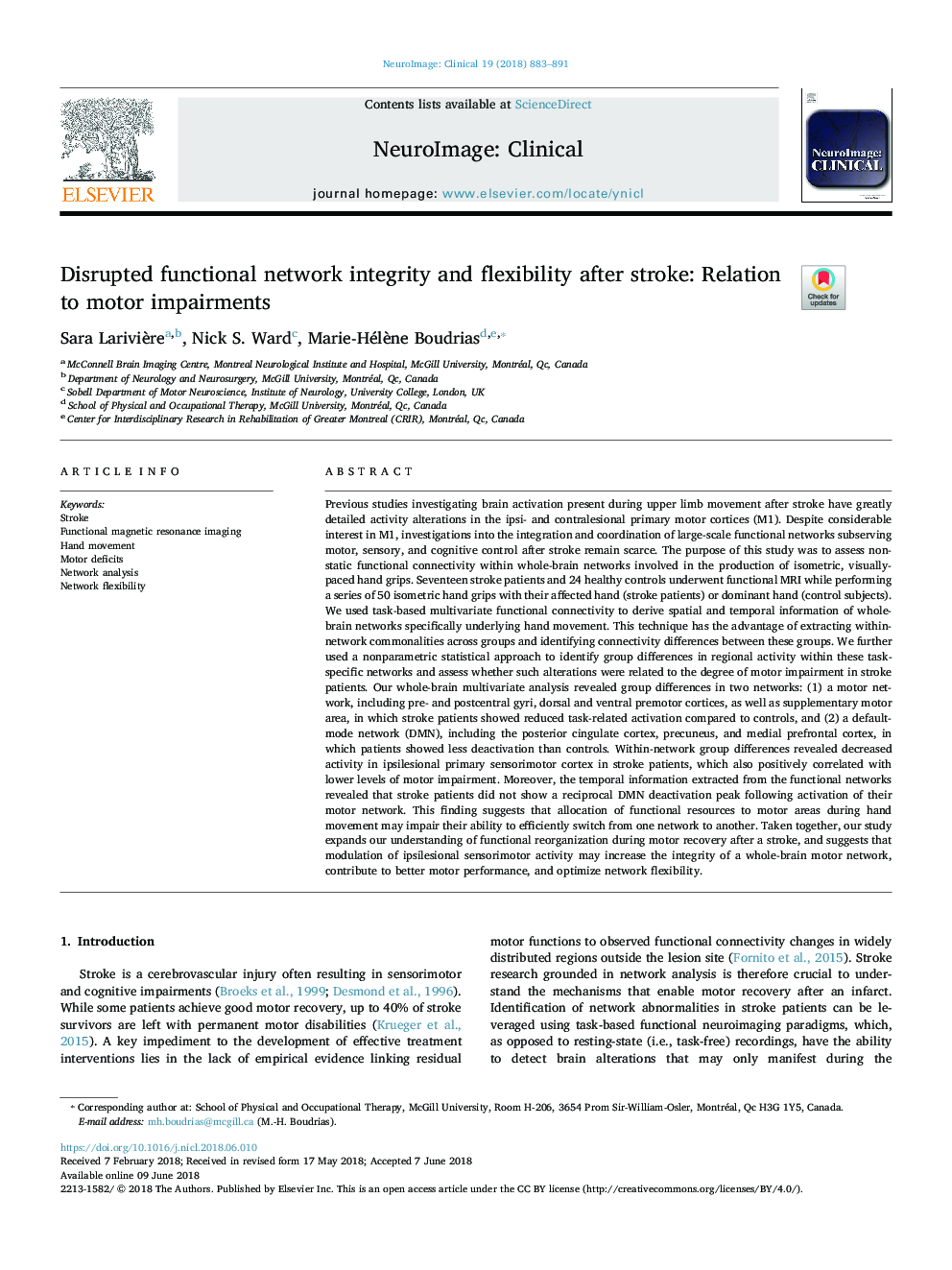| کد مقاله | کد نشریه | سال انتشار | مقاله انگلیسی | نسخه تمام متن |
|---|---|---|---|---|
| 8687809 | 1580948 | 2018 | 9 صفحه PDF | دانلود رایگان |
عنوان انگلیسی مقاله ISI
Disrupted functional network integrity and flexibility after stroke: Relation to motor impairments
ترجمه فارسی عنوان
یکپارچگی و انعطاف پذیر بودن عملکرد شبکه بعد از سکته مغزی: ارتباط با اختلالات حرکتی
دانلود مقاله + سفارش ترجمه
دانلود مقاله ISI انگلیسی
رایگان برای ایرانیان
کلمات کلیدی
سکته مغزی تصویربرداری رزونانس مغناطیسی عملکردی، جنبش دست، نقص موتور، تجزیه و تحلیل شبکه، انعطاف پذیری شبکه،
موضوعات مرتبط
علوم زیستی و بیوفناوری
علم عصب شناسی
روانپزشکی بیولوژیکی
چکیده انگلیسی
Previous studies investigating brain activation present during upper limb movement after stroke have greatly detailed activity alterations in the ipsi- and contralesional primary motor cortices (M1). Despite considerable interest in M1, investigations into the integration and coordination of large-scale functional networks subserving motor, sensory, and cognitive control after stroke remain scarce. The purpose of this study was to assess non-static functional connectivity within whole-brain networks involved in the production of isometric, visually-paced hand grips. Seventeen stroke patients and 24 healthy controls underwent functional MRI while performing a series of 50 isometric hand grips with their affected hand (stroke patients) or dominant hand (control subjects). We used task-based multivariate functional connectivity to derive spatial and temporal information of whole-brain networks specifically underlying hand movement. This technique has the advantage of extracting within-network commonalities across groups and identifying connectivity differences between these groups. We further used a nonparametric statistical approach to identify group differences in regional activity within these task-specific networks and assess whether such alterations were related to the degree of motor impairment in stroke patients. Our whole-brain multivariate analysis revealed group differences in two networks: (1) a motor network, including pre- and postcentral gyri, dorsal and ventral premotor cortices, as well as supplementary motor area, in which stroke patients showed reduced task-related activation compared to controls, and (2) a default-mode network (DMN), including the posterior cingulate cortex, precuneus, and medial prefrontal cortex, in which patients showed less deactivation than controls. Within-network group differences revealed decreased activity in ipsilesional primary sensorimotor cortex in stroke patients, which also positively correlated with lower levels of motor impairment. Moreover, the temporal information extracted from the functional networks revealed that stroke patients did not show a reciprocal DMN deactivation peak following activation of their motor network. This finding suggests that allocation of functional resources to motor areas during hand movement may impair their ability to efficiently switch from one network to another. Taken together, our study expands our understanding of functional reorganization during motor recovery after a stroke, and suggests that modulation of ipsilesional sensorimotor activity may increase the integrity of a whole-brain motor network, contribute to better motor performance, and optimize network flexibility.
ناشر
Database: Elsevier - ScienceDirect (ساینس دایرکت)
Journal: NeuroImage: Clinical - Volume 19, 2018, Pages 883-891
Journal: NeuroImage: Clinical - Volume 19, 2018, Pages 883-891
نویسندگان
Sara Larivière, Nick S. Ward, Marie-Hélène Boudrias,
